
For three of the four nurseries on the Mountains & Meadows Nursery Tour of the Canwest Hort Show, greenhouses were only part of much larger operations.
For three of the four nurseries on the Mountains & Meadows Nursery Tour of the Canwest Hort Show, greenhouses were only part of much larger operations.
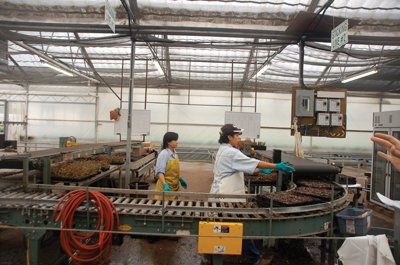
|
|
| Automation and cuttings | |
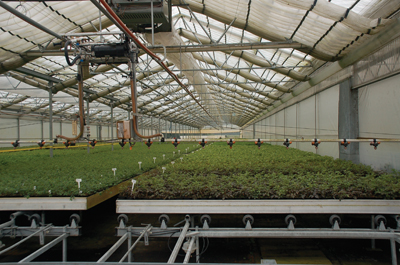
|
|
| two-acre greenhouse to root new cuttings. |
VAN BELLE NURSERY
Van Belle Nursery has only limited greenhouse space among its 80 acres spread over three farms in the Abbotsford area. Its product mix includes over 200 perennials, including 40 different vines. The greenhouses are used primarily for propagation, as Van Belle propagates over two million plants each year.
The propagation is done at the company’s Clayburn location. Although it is within two kilometres of the other sites, its location at the foot of a hill makes it a zone warmer.
Cuttings are planted in liners using an automated system, then put in a two-acre greenhouse for four to eight weeks to root. Once rooted, the plants are moved outside onto an 8.5-acre bench rail system.
“We believe this is the largest bench rail system in North America,” the Van Belles say, adding the tightly packed system “saves us two acres in roadways.”
It is a manual system but designed so workers can effortlessly move up to 6,000 plants at a time. Being manual, the system means all plants are inspected as they are moved onto the benches and again when they are removed, providing excellent quality control. Specially built equipment also allows Van Belle to do customized spraying and pruning. “We prefer to give our plants small haircuts more often,” the company explains.
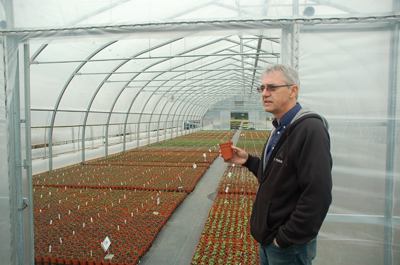
|
|
| Thousands of rock stars are growing in this poly house at Valleybrook Gardens. Each is grown in a double-lipped plastic pot which has a clay-like appearance to give them an earthy look. | |
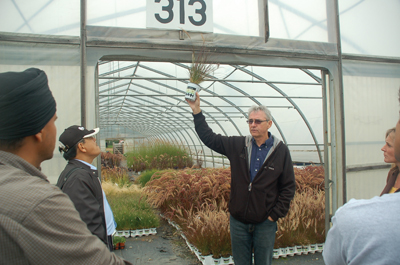
|
|
| This greenhouse is used to grow Valleybrook Gardens’ newest offering, two gallon “Big Blue” versions of their popular Heritage Perennials. |
VALLEYBROOK GARDENS
Valleybrook Gardens now has 200,000 square feet of poly greenhouses at its 25-acre Clearbrook nursery. (Valleybrook also operates a 30-acre nursery in Niagara Falls, Ontario.)
It is a far cry from the five acres John Schroeder began with in 1980, an expansion fuelled by distinctive pots and branding. Heritage Perennials, well known for their square blue pots, now includes a two-gallon “Big Blue,” Jeepers Creepers, Rock Stars and now, Hort Couture – exotic annuals, grasses and tropicals in decorative Hollywood retro pots geared to trend-conscious consumers.
“Our pot is an opportunity to market our product,” Schroeder says. “Our aim is to give independent garden centres an identifiable brand complete with point of purchase sales material. We sell them for more to garden centres and they can sell them for more.”
Despite his clever marketing, Schroeder admits 2008 was not Valleybrook’s best year. “Normally, we do over half of the year’s business from mid-April to the end of May. Last spring we grew 15 per cent more but the bad spring kept product from moving. We are only now (by mid-September) catching up to last year’s sales.”
With perennial sales slowing, Schroeder has started growing ground cover roses to add to his product mix, saying “we must never forget we are producers of a consumer product.”
Valleybrook brings in unrooted cuttings from Costa Rica and Guatemala, plants them in plugs and starts them on heated benches. They use cheaper bench heating rather than overhead heating because “we only need to heat the roots.”
Because of the wide variety of plants being grown, Schroeder has invested in equipment and facilities that can be used for small quantities and a wide variety of plants.
During winter, the ever-creative Schroeder converts one of his unheated greenhouses into a storage shed. Plants to be over-wintered are stacked five levels high in shipping containers and stored in the greenhouse. “We aren’t trying to grow the plants in winter, so storing them this way makes sense.”
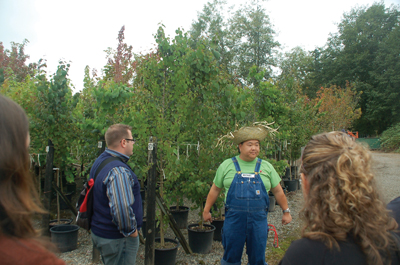
|
|
| Michael Kato shows off his containerized “mini-van” trees. These smaller offerings allow consumers to take them home from a nursery or garden centre in a car or minivan. | |
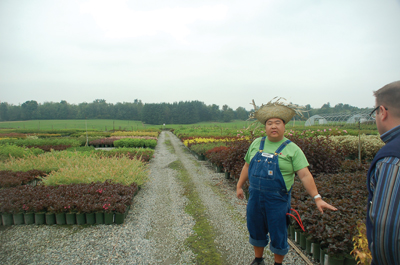 |
|
| Michael Kato grows about 500,000 plants and roots about 400,000 cuttings on his 30-acre nursery in Abbotsford. The farm has been sculpted to permit most of the water to drain into two collection ditches on either side of the farm. |
KATO’S NURSERY
At Kato’s Nursery in Aldergrove, greenhouses cover only about six acres of the 30-acre site, but that is changing.
Now owned and operated by Michael Kato, the third generation to run the family operation since it was established over 50 years ago, Kato’s grows about 500,000 plants and roots about 400,000 cuttings in Aldergrove and also grows larger caliper trees on a 60-acre site in Chilliwack. While larger trees used to be a big part of its business, the home farm has been switched to containerized “mini-van” trees. “Consumers come to the garden centre in a car or mini-van and want a tree they can take home with them,” Kato explains.
(The 2008 CanWest Hort Show theme was “Nursery Rhymes,” and Michael stayed in character to host the post-conference tour. Kato’s Nursery won “Most Original Display” and “Best Overall Exhibit” in best booth judging.)
Most of his greenhouses are cold frames, primarily intended to keep the frost off plants in the winter. “We plan to add more cold frames since we have to blow in sawdust to protect younger plants we leave out over the winter.”
A few, such as the propagation house, are heated. As a result, Kato’s can grow product for anywhere from a Zone 1 to a Zone 11 climate.
Since no products are pre-sold and most are several years old by the time they leave the nursery, correctly predicting the future market is critical.
“Everything we sell here is bought with after-tax disposable income. You don’t ever want to forget that,” Kato stresses, but adds he is not worried about a downturn in the housing market or even the overall economy. Rather than a negative, it can often be a positive for nursery growers.
“When the market is down, we’re up. When people first buy a house, they concentrate on necessities like appliances. Only after a few years do they get around to the yard. And when the economy is down, people tend not to take big vacations. Instead they do more nesting and that often means buying a few plants.”
Kato also believes the industry has a real opportunity to “ride the environmental movement,” saying nurseries have to sell their products as “net suppliers of oxygen.”
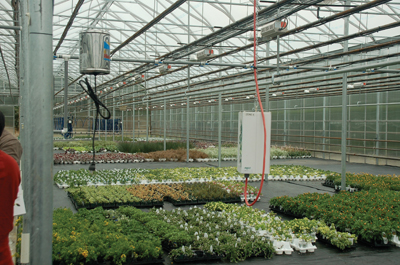
|
|
| This 1.5-acre poly house is the newest addition to Nordic Nurseries. The fully vented house stands 16 feet high at the gutter. | |
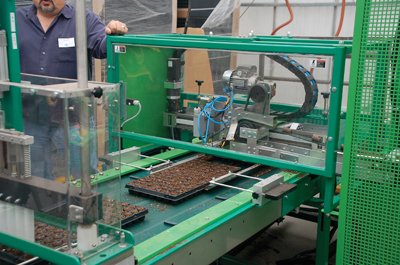 |
|
| Vegetative cuttings from Costa Rica are planted in liners using the Ellepot system. The versatile system can be run by one person, use any number of soil mixes and fill anything from propagation trays (as shown) to 120 mm pots. |
NORDIC NURSERIES
The only one of the four nurseries on the tour to work exclusively in a greenhouse is Nordic Nurseries in Abbotsford. It is one of six North American growers (three in Canada and three in the U.S.) propagating and growing the “Proven Winners” line of annual flowers.
“About 50 per cent of our business is propagation and 50 per cent is growing for garden centres,” said Nordic owner Glenn Andersen.
While a few plants are started from tissue culture, most originate as vegetative cuttings from Costa Rica. They are then planted in liners using the Ellepot system, which wraps a soil mix of the grower’s choosing in a degradable wrap before planting the plug. The system can be run by one person and fill anything from propagation trays to 120-millimetre pots.
Andersen swears by it, saying it enables air to get into the root structure. “It takes a week off the crop time and gets a lot more plants through the greenhouse.”
AT PEAK SEASON, 600,000 CUTTINGS ARE PROCESSED EACH WEEK
During its busiest season, Nordic employs up to 60 staff and processes 600,000 cuttings each week. Once planted, plugs are put on tables and under mist for three to 10 days (every table is a separate mist zone) before moving into the rest of the greenhouse where they stay for another two to three weeks before being shipped across Canada.
Nordic uses a one-acre glass greenhouse, with raised hot water heating, along with a new 1.5-acre, fully vented poly house. The poly house is 16 feet tall to the gutter, Andersen calling height the “key” to efficient ventilation. “We can actually keep the greenhouse cooler than outside in the summer.”
Print this page